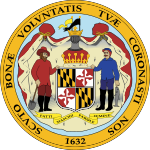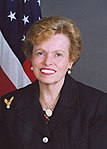| ||||||||||||||||||||
| Turnout | 60.67% | |||||||||||||||||||
|---|---|---|---|---|---|---|---|---|---|---|---|---|---|---|---|---|---|---|---|---|
| ||||||||||||||||||||
 County results Glendening: 50-60% 60-70% 70-80% Sauerbrey: 50-60% 60-70% 70-80% | ||||||||||||||||||||
| ||||||||||||||||||||
| Elections in Maryland |
|---|
 |
|
|
The 1994 Maryland gubernatorial election was held on November 8, 1994. Incumbent Democratic governor William Donald Schaefer was ineligible for re-election. Prince George's County Executive Parris Glendening emerged victorious from the Democratic primary after defeating several candidates. Maryland House minority leader Ellen Sauerbrey, who would also be the 1998 Republican nominee for governor, won her party's nomination.
In the general election, Glendening narrowly defeated Sauerbrey by a margin of 50.2 percent to 49.8 percent, or by 5,993 votes, the closest gubernatorial election in Maryland since 1919[2] and the first gubernatorial election in Maryland history to be decided by an absentee runoff.[3] Sauerbrey's campaign challenged the results of the election, filing a lawsuit alleging voter fraud and election irregularities; her claims were rejected by Anne Arundel Circuit Court Judge Raymond G. Thieme Jr. in January 1995.[4]
This election marked the first time since 1915 that a Democrat won Maryland without Baltimore County, the first time since 1930 that a Democrat won Maryland without Cecil County, and the first time since 1919 that a Democrat won without St. Mary's County.[5][6] This is the last time Howard County voted for the statewide loser.
- ^ "1994 Gubernatorial Election". elections.maryland.gov. Maryland State Board of Elections. Retrieved May 1, 2022.
- ^ Rasmussen, Frederick N. (November 10, 1994). "Maryland's last cliffhanger was 1919 governor's race". The Baltimore Sun. Retrieved March 10, 2024.
- ^ Frece, John W. (November 9, 1994). "Republicans anticipated absentee role". The Baltimore Sun. Retrieved March 10, 2024.
- ^ Montgomery, David (January 14, 1995). "Judge rejects Sauerbrey's bid to overturn vote in Maryland". The Washington Post. Retrieved March 10, 2024.
- ^ "Archives of Maryland, Volume 0126, Page 0249 - Maryland Manual, 1915-16". msa.maryland.gov. Retrieved January 17, 2022.
- ^ Maryland Manual. Hall of Records Commission. 1987.


